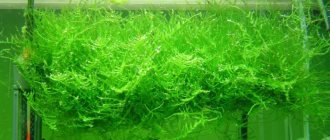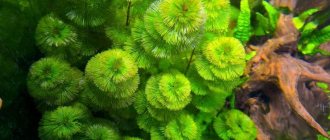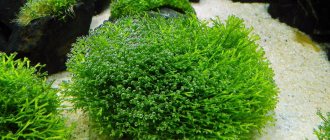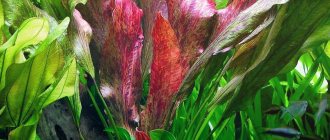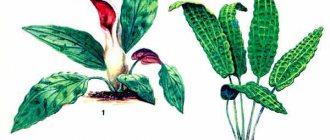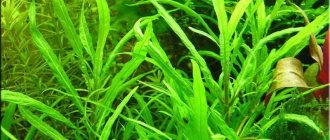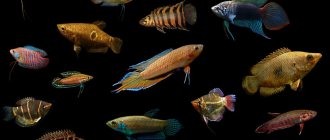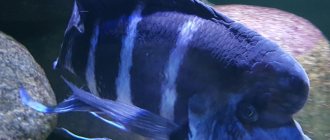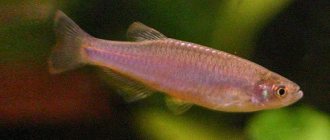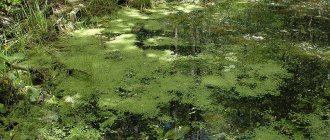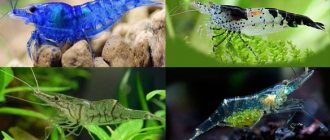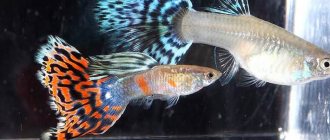Hygrophila is an aquatic herbaceous plant that is popular among aquascapers due to the variety of species that differ in the shape and color of the leaf blades. It belongs to the Acanthaceae family, representatives of which can often be found among lovers of home “jungles”. Seeing hygrophila in the design of a home pond, it is difficult to imagine that its “relatives” are represented by shrubs, vines and form mangroves in the tidal zone of the tropics. There are more than 90 species of plants belonging to the genus Hygrophila. But only a few of them can exist under water permanently.
Botanical description and natural habitat
Belongs to the Acanthus family, genus Flowering Dicotyledons. There are about 100 varieties of Hygrophila, which differ from each other in the color and shape of the leaves, as well as the size of the bushes. The homeland of this plant is considered to be Southeast Asia, where a humid tropical climate prevails. Moreover, it can grow both on land and in water, being essentially an amphibian. Prefers bodies of water with a slow flow (small rivers, channels) or without it (wetlands, for example, lakes and ponds). Favorite location: shallow water with plenty of sun, avoids shady areas. The optimal temperature range for growth is from +18…+30 °C. Loves nutritious soil.
Photo gallery Hygrophila:
Outwardly it looks like bushes with small, long, elongated leaves arranged in pairs. The color in natural conditions is rich green on top, and silver on the back. They can reach 20 cm in length and about 2 cm in width. Under optimal conditions, the plant can grow up to 20-30 cm in height, and up to 15 cm to the sides.
It propagates vegetatively, that is, by parts of the stem or leaves. Due to the almost continuous cycle of rebirth, the exact lifespan is impossible to determine.
Habitat indicator
Hygrophila compact is a good environmental indicator. By appearance you can understand which microelements it lacks.
If there is not enough potassium, then the external signs of the plant will appear as follows:
- Small holes will begin to appear on the leaves, most often the lower ones;
- New leaves will begin to grow smaller in size;
- The leaves begin to curl, become deformed, the lower ones and completely fall off;
- Leaf blades turn yellow;
- Slowly growing;
- The tops are dying off.
With a lack of phosphorus, the following occurs:
New growing leaves become dark green with a reddish tint.
2011-2020 “Aquarium in your home” - online magazine for aquarium lovers. When copying materials reference to the source is required!
Mr. Tail recommends: varieties
A large number of varieties have now been bred for keeping in aquarium conditions. Among the most popular are the following.
Polyspermous marbled Hygrophila
Most popular among aquarists with little experience. The leaves are oval in shape, reach 6 cm in length and 3 cm in width. They are colored light green in water and red-burgundy in air. Thanks to the veins of white, orange, red, yellow, it produces an unusual pattern, for which it is valued. The stem is elongated. The bushes grow up to 40 cm in height and 10 cm in circumference.
Feels good in any aquarium, regardless of its size. With sufficiently intense lighting, the species tends to turn red foliage. For this variety, it is preferable to use fairly fine soil; the diameter of the grains of sand should be no more than 3-4 mm. With prolonged (at least 10 hours) and intense lighting it grows more abundantly.
If there is a lack of light, it begins to stretch in length and the size and number of leaves decreases, which spoils the appearance of the plant.
Hygrophila varifolia or sinema
This is a very popular variety among aquarists. It has a fairly long stem, the shape of the leaves varies depending on the light intensity. They can be oval or large-cut. It is unpretentious to living conditions and can grow in an aquarium of any size. Usually planted in the center, as it is very beautiful and will be a highlight.
Prefers warm water from +24...+26 °C, but can easily withstand temperatures down to +20 °C. Under cool conditions, it begins to grow more slowly.
If the lighting is natural or moderate artificial, small oval sheets form on Hygrophile; when the light intensity increases, they increase in size and become carved, openwork, patterned.
Another unusual feature of this species of Hygrophila is that it can either simply float in water or take root in the soil. With both types of accommodation he feels equally good. For planting in the ground, you should give preference to a mixture of sand with small pebbles with the addition of peat and clay, but it also grows quietly in larger masses. The thickness of the soil layer does not have strict parameters; any will do.
It propagates, like other varieties, by cuttings; you can also leave a torn leaf floating in the water and after a while roots will appear on it. After this, it can be planted in the ground.
This Hygrophil species grows well in greenhouses with high air humidity. It is enough to transplant the aquatic plant with its roots into nutritious soil and ensure timely watering and spraying of the leaves.
Willow Hygrophila or longifolia
The largest representative of the family, it grows up to 40 cm long. It has long leaves (about 12 cm) of light green color with a smooth or jagged edge, similar to willow, which is how it got its name. Moreover, the upper surface is slightly darker than the back.
If part of the plant peeks out of the water, small white flowers may appear located in the axils between the leaves.
Does well in taller aquariums as it tends to grow in length. Plant on the sides and at the back wall.
Loves intense lighting; lamps must have a power of at least 0.5 W per 1 liter of water and long daylight hours (about 10-12 hours). Under these conditions, the leaves take on a brown tint, and the middle vein remains green, which makes the plant unusual and expressive.
It is unpretentious to living conditions, but feels best in tropical aquariums with an ambient temperature of +22...+26 °C. It is important to choose the right soil; it must be sufficiently nutritious, because Hygrophila has a developed root system. To do this, mix a little peat and clay into the substrate (sand or small pebbles).
Hygrophila aguaia
It is classified as short, but very beautiful. The most demanding in terms of growing conditions, compared to other varieties. In its natural habitat it prefers to settle in the shallow waters of Brazilian and Japanese rivers. It was first discovered and described in 2006, but has already gained popularity among aquarists, both amateurs and professionals.
Hygrophila reddish
The rarest representative among aquarium varieties. The plant has a long stem with long and narrow leaves, colored brownish-red or pinkish. They are about 8 cm long and 0.5 cm wide.
Due to the ability of Hygrophila Russet to grow in height, it is worth placing it near the side and back walls of the aquarium. It is important to organize a long day of light (about 10-12 hours) with good intensity (0.4 W per 1 liter of water).
The temperature regime prefers around +24 °C; in colder environments, the color begins to fade, the lower leaves fall off, the trunk becomes thinner and elongated, causing it to lose its attractiveness.
Hygrophila pinnatifida
This is a very beautiful and unusual plant, loved by many aquarists. It grows quite slowly, but this is more of an advantage than a disadvantage. It can reach from 15 to 30 cm in length. The color of the foliage is variable and depends on the intensity and duration of lighting. It can be either green or reddish-burgundy with pink. The roots are extremely poorly developed, so nutritional value and soil fraction are not so important for it. It can even be attached to large bottom stones and snags.
It feels most comfortable in water +23…+26 °C and at a pH of 5.5-7.5.
If an aquarist wants to maintain a compact shape, then you need to monitor the lighting intensity (the lamp must be at least 5 W per 1 liter of container) and promptly remove side shoots. Looks best in compositions in the middle, next to taller species.
Hygrophila Schisandra Carimbosa
This species is also called Normophila straight or Thyroid. It has a long and strong stem with oval elongated leaves with a sharp tip. Painted light green on the top surface and silver on the back.
Looks best when planted along the sides and back walls of the aquarium.
It prefers water temperatures from +24...+27 °C, and grows more slowly in colder waters. The hardness should be about 8°; if it is less (softer), the sheets will become brittle and begin to collapse, thereby exposing the stem. It is necessary to change 1/3 of the water every 7 days.
Loves intense lighting and long daylight hours (at least 10 hours). If this condition is not met, the plant begins to feel unwell, which leads to the destruction of the foliage and a deterioration in the appearance for which it is so valued.
The soil should be nutritious and at least 5, and preferably 7 cm thick, because its roots are well developed.
Hygrophila siamese
Thailand is considered its homeland. Outwardly similar to lemongrass, but the leaves sometimes acquire a bluish and lilac tint. The roots are well developed, which requires a nutrient substrate in the soil and its thickness of 5-7 cm. When the plant rises above the water level, small blue flowers appear on the protruding parts.
This species is extremely unpretentious to the parameters of the aquatic environment, and therefore can be planted even by novice aquarium lovers. Grows at temperatures from +22...+28 °C, hardness 4-14° and pH from 5.5 to 8.
To ensure that the plant bushes and does not stretch upward, the tops are pinched, then numerous side shoots appear.
Purple leaves
Hygrophila violet is a rare hybrid form. It has a long stem and purple colored leaves. The leaf blades are located opposite. Hygrophila can grow in both low and high aquariums.
Hygrophila violet requires good lighting in an aquarium.
In containers of small height, it forms a lush surface part. It is usually planted near the side walls or in the background. Together with green plants, Hygrophila violet forms a beautiful bright group.
In order for the plant to maintain its intense color, it requires prolonged light. In addition to the overhead light, it is also necessary to organize side lighting. Duration of illumination - from 12 hours. If there is little light, the plant will become very elongated, and its leaves will become crushed and lose their purple color.
Hygrophila requires nutritious soil from coarse sand and mineral fertilizing. In this case, it forms lush bushes with brightly colored leaves. The water temperature should be from +24° to +28°C. The plant needs soft water - if it is too hard it becomes fragile.
Hygrophila purpurea is propagated by cuttings. To make them, a healthy plant stem is cut into pieces with two or three pairs of leaves. The cuttings are left to float in the aquarium until roots appear, after which they are planted in the ground.
Aquarium Basics
Like any plant, Hygrophila has its own maintenance characteristics and requirements for water parameters. It is important to pay attention to the following.
Priming
It should be fine, silty, small fractions of sand or pebbles, with a diameter of about 3-4 mm, work well. There are also increased requirements for its nutritional value, since Hygrophila has a developed root system. To do this, clay and peat are added to the substrate in small quantities. The soil is poured onto the bottom with a thickness of 4-6 cm. This is most optimal for the plant.
Requirements for water parameters
If they are followed, the plant will grow well and delight with its appearance. These include:
- Temperature. Should fluctuate between +20…+26 °C.
- Hardness from 3 to 15 °. In harder water, the stem becomes thin and brittle, and the leaves become thinner.
- Acidity is most optimal in the range of 6.5-7.5 pH.
- A weekly change of 30% of the water to settled water is required.
- Careful filtration is required. Any medium power device will do.
- It is unpretentious to aeration, but you should not run the aquarium too much, otherwise the leaves will begin to die and thin out, which will affect the appearance of the plant.
Aquarium dimensions
They depend on how many Hygrophila bushes and what varieties the aquarist is going to plant. On average, the width of each plant reaches about 15 cm, and the optimal distance between them should be 5-10 cm. This will ensure quiet growth and protect against intertwining of root systems, which can negatively affect the growth and beauty of Hygrophila.
Lighting
It can be: natural, artificial, but the most optimally combined. At the same time, it is worth protecting Hygrophila from direct sunlight, as it can cause burns and yellowing of the sheets.
Lamps (preferably fluorescent) with medium or low power are suitable, that is, they are purchased at the rate of 0.5 to 0.6 W per 1 liter of water. It is important not to forget about the duration of daylight hours; it should be 10-12 hours.
Appearance
Dwarf lemongrass appeared thanks to selection in the Netherlands. It differs from ordinary hygrophila in its small size. The plant most often grows in height from 10 to 15 cm. The strongly flattened stem of hygrophila begins to branch right at the root, and many leaves are formed, with a small distance between them. Dwarf lemongrass is capable of forming a large number of lateral shoots. The leaf blades of the plant are light green, silvery on the reverse side. After pinching the top stops the growth of the main stem, the lemongrass begins to branch quite quickly, resulting in dense bushes. In this form, the plant is often compared to Japanese bonsai. Dwarf lemongrass is valued for its high decorative properties. These are compact bushes with a lot of leaves. It can look great against the background of other aquarium plants. Hygrophila corymbosa compacta grows at an average speed. This property distinguishes it from other Hygrofils, which have a high growth rate and require more time to care for them.
Diseases and pests
If the rules for caring for Hygrophila are violated, it grows greatly and protrudes above the water level. Therefore, it is important to monitor its length and trim overgrown bushes in time. When outside the aquatic environment, the sheets can get burned and turn yellow; in this case, reduce the intensity of artificial lighting and remove them from direct sunlight (in natural conditions).
When the bush weakens, the stem becomes brittle and the foliage turns pale, you should pay attention to the parameters of the aquatic environment and normalize them. After this, she will return to her original beauty.
Hygrophila is a very beautiful and unusual plant, which, with proper care and maintenance, will delight you with its appearance for many years.
How to reproduce?
First, separate the upper shoots of already mature lemongrass and plant them in fine soil; pebbles are also sometimes used. When cutting the top part, side shoots are obtained, which should also be separated and planted in fine soil or pebbles. Thus, provided that the root and part of the stem are preserved in the soil, you can get an aquarium lemongrass plant with side shoots.
As soon as the process of self-propagation of the plant is completed, you can begin planting your “pet”. If you have been breeding aquarium lemongrass yourself at home, then after planting it, you should closely monitor its “health” for a while so that in case of any problems your plant does not die.
See the video below for more information about the aquarium plant Schisandra.
Benefits for the aquarium
This is a very useful plant for the aquarium. The benefits of hygrophila loosestrife are expressed in the following:
- It can process nitrates contained in water, gradually reducing their amount to zero.
- The plant filters and at the same time purifies the water, thus saving the fish from the possibility of getting sick.
- Hygrophila saturates the water with oxygen, which is also necessary for the comfortable life of fish.
- Many species prefer to lay their eggs in these dense thickets. The fry will feel protected in the hygrophila leaves and will be able to grow to large sizes.
Many species prefer to lay their eggs in these dense thickets.
Name variations
Hygrophila loosestrife has many name variations.
This is due to the fact that when looking at a plant many associations arise. The official name “willow leaf” was obtained due to the similarity of this aquatic plant to the weeping willow. The name “hygrophila angustifolia” was given much later.
Many people confuse hygrophila and salicyfolia loosestrife. But these are two different plants; there is also Hygrophila sinema or Hygrophila Schisandra.
Hygrophila has very narrow and long leaves
“Hygrophila longifolia” is a newer name, also found in the scientific literature. All variations in the names of this plant are associated with the external characteristics of hygrophila. It really has very narrow and long leaves that resemble willow.
Compatibility with other inhabitants in the aquarium
Aquarists do not recommend planting Hygrophila willow next to large aquarium snails. These slow-moving creatures can feast on hygrophila and nibble on its foliage. Achatina and Neretina are partial to sea plants, so they will quickly render the leaves unusable.
But for schooling fish, hygrophila will be a real salvation. These species will get along well with each other. Guppies, tetras and swordtails will hide in the bushes and lay eggs in them.
Hygrophila gets along well with bottom fish
Hygrophila over time acquires a powerful root system. This means it will get along well with bottom-dwelling fish. Among them are catfish and other representatives of calm and slow aquarium inhabitants who do not like active movement and are accustomed to burying themselves in the ground.
Where does it live?
Hygrophila pinnatifida was first identified in India, which is why this country is its homeland. Most often, the plant can be found in shallow streams that flow at the foot of the mountain range. It is on the western side of Hindustan (a small peninsula in southern Asia).
The plant is native to India
Useful lifehacks
To ensure that willow hygrophila brings pleasure, we offer several important tips for study:
- Hygrophila should be introduced into the aquarium in order to clean it. For example, from nitrates, toxins or waste products of other residents.
- If, after time, the plant still cannot take root and begins to float, then in this case you need to use one simple method. The hygrophila is tied to a stainless nut and, with its help, attached to the bottom.
- Hygrophila loosestrife goes well with other types of aquarium plants. It is important that all these residents have similar requirements for living conditions, for example, water parameters, temperature and cleanliness.
- If you notice holes appearing on older Hygrophila leaves, this means the plants are deficient in potassium.
- But if white dots appear on the leaves, this is due to iron deficiency.
- Yellowing of hygrophila is associated with a lack of nitrates.
- If hygrophila does not take root well, you can buy special preparations that contain phytohormones. They are aimed at stimulating and growing the root system and its development. After a course of this drug, hygrophila quickly takes root and begins to grow.
Aquarists often use hygrophila to create beautiful decorations inside the aquarium. It goes perfectly with driftwood, clay or plastic products, and looks good among shells, large stones and sandy soil.
Fish also like the opportunity to hide in leaves, lay eggs there, hide or even sleep.
Hygrophila grows quickly in good conditions
Hygrophila grows quickly in good conditions, so it needs to be thinned once a month. If this is not done, the plant will very quickly fill all the available space, robbing the fish of space to move around.
In one aquarium it is permissible to combine several species of hygrophila, and then the picture will look more juicy and bright. And experienced aquarists create real ideas with landscape design, turning the aquarium into an underwater fairy tale.
When purchasing hygrophila, do not forget about the need for quarantine. Otherwise, there is a high risk of infecting all the inhabitants of the aquarium with any infection brought from the nursery. If the plant is absolutely healthy, then soon you will have a real green wall, replacing photo wallpaper.
Reproduction
Nomafila propagates using cuttings. To get new lemongrass, aquarists cut off the upper shoots of the flower and plant them in the substrate, thus propagating one specimen. In order for the sprout to take root, feel good, and develop, a piece of clay is placed under the roots, or the shoot is planted in a clay pot, thus preventing the risk of fish digging up the flower.
There is another way to propagate nomaphila. A young twig, cut from the top of the plant, is left to float on the surface of the water surface. True, in the case of such breeding, the lemongrass leaves will be twisted, as they will actively reach for the light, and this can no longer be corrected. Cutting off nomafile sprouts does not harm, but on the contrary, increases its growth and splendor.
Schisandra is a beautiful ornamental plant that will transform and decorate any artificial pond. Caring for nomaphila is not difficult: the flower with a citrus aroma is responsive, easily reproduces and brings great benefits to the inhabitants of the aquarium. Under good conditions, lemongrass will bloom with lilac flowers and delight its owner.
